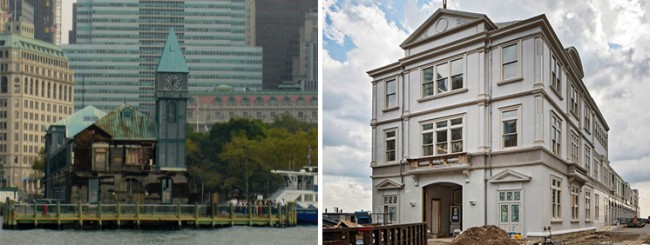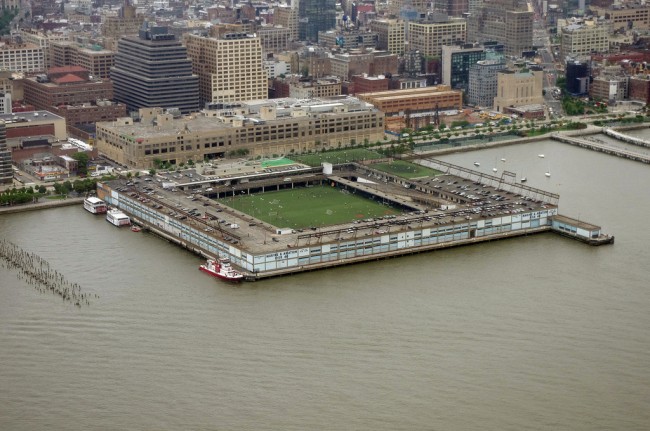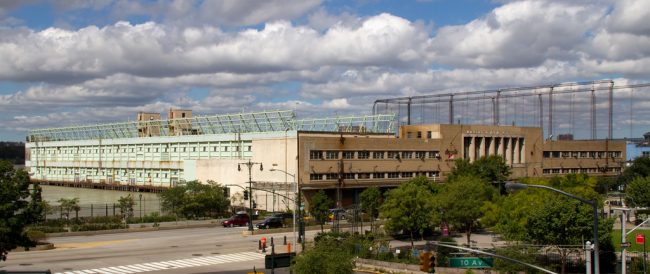
We are celebrating 15 years — and counting — of stories that are deeply researched and deeply felt, that build a historical record of what the city has been.
We are celebrating 15 years — and counting — of stories that are deeply researched and deeply felt, that build a historical record of what the city has been.
Historical maps and old aerial photographs show New York’s shores wrapped with piers reaching out into the water to connect the streets and businesses of a port city to the world. This waterfront has transitioned over time as hives of commerce became post-industrial relics and, most recently, destinations for recreation and real estate development. (Earlier this summer, Curbed posted a nice photographic comparison of the past and present of New York’s piers.) Though many of those piers have long since disappeared, those that remain are being recognized as a significant resource for public (and semi-public) use and many are being transformed into sites of leisure, practice, production, and exposition. Below is a brief overview of just some of the recent development and future plans for the city’s shores.

(L) Pier A before and (R) undergoing restoration | (L) via Marionzetta; (R) via H3 Hardy Collaboration Architecture
Pier A | Battery Park
After years of stops and starts, restoration work is well underway at Pier A. Plans include an oyster bar and catering hall expected to open in 2014, but that date might be in question as worse-than-expected structural issues and damage from Hurricane Sandy have added to an already over budget restoration and ongoing disputes over who will pay.
Pier 6 | Brooklyn Bridge Park
The Brooklyn Bridge Park Conservancy unveiled new renderings for the undeveloped half of Pier 6 last month. With landscape designed by Michael Van Valkenburgh and an elevated triangular platform for skyline viewing and concerts designed by BIG — an addition lauded by New York Times architecture critic Michael Kimmelman — the project is the latest step in the ongoing transformation of former industrial waterfront into 1.3 miles of world class waterfront park. Funding is in place for the new landscape, but not yet for BIG’s architectural element, and no construction timeline has been announced. (For more on the history of the development of Brooklyn Bridge Park over more than a decade, look back at “Park As Process: Brooklyn Bridge Park.”)
Pier 15 | South Street Seaport
Opened in 2011 after a redesign by SHoP Architects, Pier 15 was one of the earliest pieces of the New York City Economic Development Corporation’s (NYCEDC) East River Waterfront Esplanade to be completed, and has been well utilized since.
Pier 17 | South Street Seaport
The Pier 17 Mall opened 28 years ago as a “festival marketplace” at the old South Street Seaport, but over time its t-shirt shops and chain stores attracted more tourists than locals. This summer, the area surrounding the mall was temporarily reinvented through a series of programming called “See/Change” with pop-up shops in shipping containers, evening movie screenings, and an outdoor food and drink pavilion in an effort to support businesses after Hurricane Sandy. Earlier this month, the Pier 17 Mall closed in preparation for a new mall with higher-end retail, greater public access to the waterfront, a 10,000-square-foot roof deck and a design meant to resemble city blocks. In the adjacent Link Building, a food market will replace the existing New Amsterdam Market, an independently organized public market that fought to preserve their activities in the space. Completion is scheduled for 2015.
Pier 35/36/42 | Two Bridges
These three “separate piers” share one continuous structure along the waterfront of Manhattan’s Two Bridges neighborhood.
Pier 35: The northern post of NYEDC’s multi-year East River Waterfront Esplanade, Pier 35 is undergoing structural work for transformation into a “destination pier” with landscaped open space and a ecological restoration project (including new habitat for mussels). A waterfront esplanade will provide 1,000 linear feet of additional park space south of the pier with basketball courts, petanque/bocce courts, and exercise areas. Completion is scheduled for June 2014.
Pier 36: Pier 26 is home to a large, private event space and the privately run Basketball City, as well as Department of Sanitation facilities.
Pier 42: Work to turn Pier 42, Manhattan’s last working cargo pier until its closure in 1987, into public parkland is currently in the master planning stage. In July, Urban Omnibus sat down with Hester Street Collaborative to discuss Paths to Pier 42, an interim strategy to activate the unused space while plans for a permanent park at the site are in development.

Pier 40 | Photo via David Shankbone
Pier 40 | Hudson Square/West Village
Pier 40 was previously one of the main revenue generators for the financially struggling Hudson River Park Trust, but now it is in serious need of financing itself, for both immediate structural repairs and long-term maintenance. Dueling proposals for the future of the pier were presented earlier this year. The Pier 40 Champions, a group of seven youth sports leagues, teamed up with WXY Architecture + Urban Design on a plan that would create 10.5 acres of open space, including new sports fields and an elevated running track, all financed by a 600-residential-unit development on what is now a parking lot. Real estate mogul Douglas Durst teamed up with Dattner Architects to propose a markedly different strategy that would create commercial space “likely occupied by tech firms, art galleries, and other decidedly downtown tenants,” as well as more parking. The Pier 40 Champions scored a victory this summer when state officials amended existing legislation to allow the proposed residential development, but exactly which proposal will win out is still in question.
As for engineering specifics, new technologies could play a part in keeping the pier afloat. In April, the NYCEDC announced the results of their Change the Course competition. The winner proposed utilizing 3D printing to encase the pilings of crumbling piers in protective concrete. According to Crain’s, “the city hopes to install a pilot as soon as they are ready.”

Pier 57 | Image via Tony Hisgett
Pier 57 | Chelsea
Construction begins soon to transform Pier 57 into a $200 million development with food, retail, and office/incubator space for “creative companies” after years of proposals, plans, and approvals. LOT-EK’s design for the renovation includes extensive use of shipping containers, many of which were on display in a one week pop-up to preview the future of the site coinciding with New York Fashion Week.
The views expressed here are those of the authors only and do not reflect the position of The Architectural League of New York.